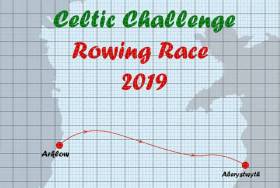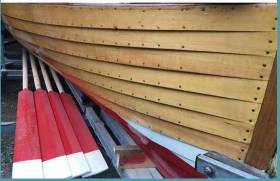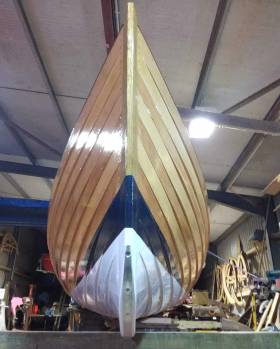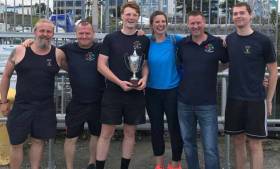Displaying items by tag: Coastal Rowing
Naomhoga Chorcaigh to Row in Navigatio Santander & Pay Respects to Late Poet Danny Sheehy
Traditional Irish currachs will compete in a Spanish rowing race next week and the crews also hope to will visit the Galician Naomhog exhibition dedicated to the memory of the late poet Danny Sheehy.
Naomhoga Chorcaigh is taking six currachs to Santander next week for a trial version of “Navigatio Santander” – a 22-km rowing race being developed in the fashion of Cork’s Ocean to City Event in Spain.
After the race, the boats will be taken to Vigo where the group that includes Drascombe and traditional boat sailor Jack O'Keefe will visit the Naomhog exhibition reported by Afloat here.
If the weather allows – the currachs will be rowed from Vigo to A Guarda to participate in the 14th Encontro de Embarcationes de Galicia. More here.
As Afloat readers will know, A Guarda is where Danny Sheehy was lost – and the Cork crew intend to pay their respects.
As Afloat previously reported here, on the May bank holiday weekend (3rd to 6th of May), St. Michael’s Rowing Club Dún Laoghaire participated in the world’s longest true coastal rowing race, the Celtic Challenge, making their way from Arklow to Aberystwyth on the Welsh coast, covering a distance of 90 nautical miles. The two crews set off at 11.50am on Sunday and rowed through the night to reach Wales at 6.59am and 8.24am respectively on Monday morning.
For the skiff crew, Captained by Stephen Ring, making it across the line in 20h and 34min meant the realisation of a dream that started four years ago.
‘’We started training for the 2016 Challenge in October of 2015,’ Stephen Ring said. ‘’When the 2016 event was cancelled due to adverse weather, many of those disappointed resolved to try again for the 2017 race. Having battled through the night, the skiff crew were within a few miles of the shore when their tiller broke and they were forced to abandon the race. But 2019 was our year, and the 8 men and 4 women made sure that every stroke was an honest stroke and brought the St. Michael over the line to achieve that dream.’
Jake Byrne, the youngest male rower in the boat was part of the 2017 crew. ‘’Last time we came so close. So close. But this year, I was determined that nothing was going to stop us. We even brought an extra tiller with us, just in case.”
The all female crew entered the race as defending champions. And defend they did. They powered through the night, finishing the race in 19h and 9min, and brought the cup back to Dún Laoghaire.
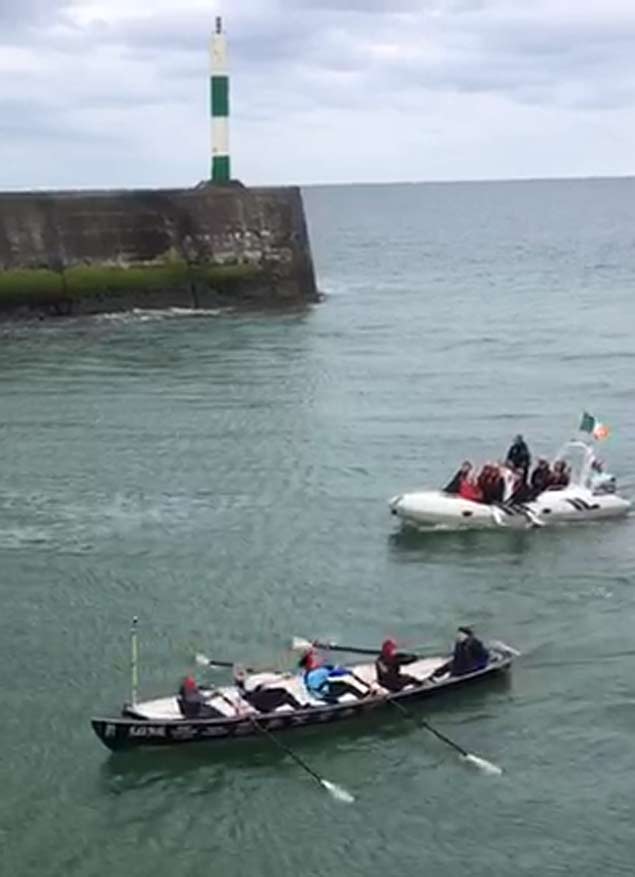 The Celtic Longboat crew crossing the finish line, with the rest of the crew close behind in the rib
The Celtic Longboat crew crossing the finish line, with the rest of the crew close behind in the rib
‘’We entered the race determined to win it, said Nicola Fitzgerald, Captain of the all female crew. ‘’We entered as a crew of 12 strong women, eager to support each other and to give everything we had. I am so proud of each of these amazing ladies, and honoured to have been their Captain through this amazing achievement. In the middle of the night, when tiredness set in, the thing that kept us going was the thought that we wanted to clock up as many miles as possible to make it easier for the next crew of four to row. We were rowing for each other, and that is not only a testimony of the spirit of the St. Michael’s club, but also of what it means to be women in sport.”
Amy Smith, the all female crew Vice-Captain said: ‘’It took 26,438 strokes to cross the Irish Sea. Our crew rowed 161.97km at an average rate of 23 strokes per minute and 7 meters per stroke. We coxed ourselves, we rowed our best and we retained our title.”
The 24 rowers were supported by two boats and two ribs. The mixed skiff crew was supported by the yacht ‘Bod’ skippered by Derek De Jong, with Michael Nolan as crew. Their rib was the ‘Niamh’ with Clive Skelly as main driver, and Mark Donnelly and Barry Aston as crew. The Celtic Longboat was supported by ‘Joe’s Buoy 2’, skippered by Paul Morton, with Brendan McLaughlin as crew and Assumpta Doherty as assistant. Their rib was the ‘Father Jack’ with Kirstan O’Toole as main driver, and Jack O’Farrell O’Toole and Isaac Matthews as crew.
‘’We could not have done it without our amazing support crews,” said Mark Crockford, who completed the Challenge in the St. Michael’s skiff. ‘’They kept us going. They were there for us. Literally.” Sarah Lovejoy, also from the skiff crew said: ‘’This is the first time I have completed the Challenge, and I am so grateful to this fantastic support team for putting up with the cold, and the waves and lack of sleep to help us achieve our dream.”
Liz O’Toole, who rowed in the Longboat, not only was grateful but also took pride in the support team for her crew. ‘My sons, Kirstan and Jack, were out there, doing the Challenge with me. They were not rowing; instead they were in the rib, which was named after my father, making sure that the ladies were safe during all the transfers to the row boat and back. I simply could not be more proud of them. The same goes for Paul Morton; without his generosity and leadership we could not have been so successful.”
The St.Michael’s rowers took on the Challenge in aid of the RNLI and the club, and their sponsors include Newstalk, Jones Engineering and Healthy Ireland. ‘’We would like to thank everyone who has donated so far, not only sponsors but our family and friends,” said Vincent Scully, member of the fundraising team for the Challenge.
James Tedd, the Club’s Chairperson said ‘’We are very proud of all our rowers. Well done to them and well done to all the crews that entered this year. A special Thank You! goes to Newquay Rowing Club for lending us the Celtic Longboat, the Black Pearl. We are very grateful to the Celtic Challenge organising committee for their efforts and efficiency. Roll on 2021!”
This May bank holiday weekend (3rd to 6th of May), St. Michael’s Rowing Club Dún Laoghaire will participate in the world’s longest true rowing race, the Celtic Challenge, making their way from Arklow to Aberystwyth on the Welsh coast, weather permitting. It will be the eighth time that the club has participated in the Celtic Challenge. Two crews from Dún Laoghaire will attempt to row 90 nautical miles across the Irish Sea in aid of the RNLI. An all female crew in a Celtic Longboat, captained by Nicola Fitzgerald, and a mixed crew made of 8 men and 4 women in a traditional east coast wooden skiff, captained by Stephen Ring.
The crews will be accompanied by one support boat and one rib each, which will help guide the rowers as they make their south easterly journey. Besides rowing, the crews have undergone intensive training with maritime experts, such as man-overboard drills and first aid courses.
This year, the stakes are high for the 12 ladies in the Celtic Longboat, as they enter as defending champions, having won their category in 2017. Nicola Fitzgerald, Captain of the all female crew, said: “We have put together a very strong and determined crew, eager to prove itself. We’ve been training hard for the past five months, on and off the water, and we are delighted to have the support of everyone in the club as we attempt to be the first to cross the finish line and bring the ladies’ trophy to Ireland again.’
The Celtic Challenge has a special place in the heart of the club’s Chairperson, James Tedd, a native of Aberystwyth. James Tedd said: “We have been very happy to see the Spirit of the Challenge trophy head to Dún Laoghaire three times already. Our mission as a club is to keep traditional Irish skiff rowing - passed on to us by the hobblers of old - alive and strong. So we take great pride in seeing the St. Michael wooden skiff, built in 1999, make its way across the sea once more, a welcome testimony to what the challenge is all about.”
Similar to other years, crews are not exclusively made of rowers who have been in the club for a long time. Amy Smith, member of the selection committee, said: “A lot of people think that it takes a great deal of mental and physical strength to complete this challenge - which is perfectly true. But equally important, is what it takes to think like a team player and to trust each other, and when we see this mentality in rowers, we know they have what it takes to join in, whether they have been members for 6 months or 16 years.”
Gary Byrne, Captain of St. Michael’s Rowing Club – Dún Laoghaire, said: “We must keep in mind that, although this challenge is about endurance, team spirit and tenacity, but it is ultimately about supporting a good cause. We strongly feel that the RNLI is a perfect match as our charity of choice, and we are asking people to help us support them.”
Dun Laoghaire's St Michael's Rowing Club in Shout Out for RIB Support for Celtic Challenge Race
This May Bank holiday weekend (May 3rd - 6th), St Michael’s Rowing Club, Dun Laoghaire will take part in the ‘Celtic Challenge’ coastal rowing race from Arklow to Aberystwyth in Wales. At a distance of 150km, this relay race is billed as the longest ‘true’ rowing race in the world and the club expects to complete the race in c.20 hours.
The Dun Laoghaire club urgently needs two support ribs for the challenge. The ribs must be a minimum of 4m in length.
If you would be willing to come along for what will be a memorable journey please contact Stephen Ring on Mobile: 087 691 9723
St Michael’s Rowing Club says it will cover all fuel costs including the crews accommodation while in Aberystwyth
Dalkey Rowing Club 'Blessing' of New East Coast Skiff “Deilginis” Takes Place in April
The blessing of Dalkey Rowing Club's new East Coast Rowing Skiff “Deilginis”, hand built by local Terence Keogh takes place on Saturday, 6th April.
Funding from the 2017 Sports Capital Programme (provided by the Department of Transport, Tourism and Sport) which, combined with money raised from fundraising events and contributions from our supporters and sponsors, allowed the Dublin Bay club the opportunity to invest in this new racing skiff.
"With the latest addition the 'Deilginis', the club now has four traditional skiffs"
With the latest addition the “Deilginis”, the club now has four traditional skiffs including what is now known as ‘the old Malachy’ built in 1953 and still used today, the “new Malachy”, and “The Coliemore” in 2015’. Dalkey Rowing Club tries to keep the sport as traditional as possible by continuing to get our hand built by local craftsman, Mr Terence Keogh hand built both “Deilginis” this year and the “Coliemore” skiff in 2015.
Dalkey Rowing Club is entering its 85th year and the club and sport is very much a traditional sport and one of the oldest in the country. Although Dalkey Rowing Club was not officially established until 1934, there is evidence of regattas taking place in Dalkey as early as 1878. Rowing along the east coast started off a necessity. Boats would row out to large vessels and ‘pilot’ them into Dublin Port. The boat that reached the ship first was the one that got the job. When the piloting work started to dry up, to keep themselves occupied, the oarsmen raced each other. And so started the east coast racing. East Coast rowing clubs now stretch all the way from Skerries down to Arklow and we compete throughout the summer season.
Event: Blessing and Launch of our New Skiff “Deilginis”
Date: Saturday 06 April
Time: 1.30pm
Location: Coliemore
Harbour
Other events in April:
Rowing Open Day for all who want to try out rowing:
Saturday April 13, 2-4pm for all 14 + Youth
Sunday April 14, 2-4pm for Adults
St. Michael’s Rowing Club, Dun Laoghaire are hosting the official launching and blessing of their new east coast rowing skiff on Saturday, the 2nd of February 2019. The event will take place at 11 am in Coal Harbour, Dun Laoghaire in the presence of club members, supporters, local community representatives and official stakeholders. Special guest for the event is boat builder Louis Hunkin of W.C Hunkin and Sons, who will be joined by his family.
St. Michael’s Rowing Club has been at the heart of Dun Láoghaire since the 1920s, ensuring the continuity of traditional Irish skiff rowing, which was passed on from the hobblers of old. In the early 1900s, the hobblers of Dún Laoghaire Harbour and elsewhere along the coast were starting to decline as a result of steam and motor engines. However, they would still race each other out to a coming ship to pilot her ashore. They also held races among themselves at the end of the week for sport. The tradition is honoured nowadays through the many skiff regattas along the east coast during the summer months.
"St. Michael’s Rowing Club has been at the heart of Dun Láoghaire since the 1920s"
“Today St. Michael’s is a vibrant and thriving club,” said James Tedd, club Chairperson. “Since 2014 our membership has more than doubled in size. It is heartening to see both youth and adult rowers embrace traditional Irish skiff rowing and carry on this tradition, especially given the fact that we count more than 15 different nationalities among our members. We take great pride in the club’s diversity and inclusive spirit, which is in line with our mission and strategy,” he added.
Gary Byrne, the club Captain, underlined that this dynamic growth in membership has led to a proportional increase in the fleet. “The Gráinne Mhaol, our new skiff, is the seventh boat in our fleet. With more than 65 training sessions per week during peak season, her arrival could not have been more opportune,” he said.
The Captain also spoke about the need for access to proper, adequate facilities for the club members. “We are one of the oldest rowing clubs on the east coast. At the moment, the only premises we have, located in Coal Harbour, are fit for storage and maintenance work,” he added. “We are active, we are determined, and we love to compete and win medals, from the youngest members, barely 10 years of age, to the most experienced vets. Access to facilities would be a huge improvement for our members, and would allow us to continue to grow and promote this sport.”
Amy Smith, club treasurer in 2017-2018, said: “We are grateful for the funding for the Gráinne Mhaol, which was provided under the 2017 Sports Capital Programme by the Department of Transport, Tourism and Sport. Many thanks also to our sponsors for today’s event: Tesco Dun Laoghaire, SuperValu Killiney and SuperValu Dun Laoghaire. And of course, huge thanks to Louis Hunkin, for building the boat and entrusting her to us.”
The ceremony is to be performed by Fr. Martin Daly who blessed not only the Gráinne Mhaol but also the new-to-the-club one design boat, Eibhlín Nua. Chris Greene, club Captain in 2017-2018, is looking forward to ensuring that the boats have a festive champagne baptism before they are launched into the Dun Laoghaire harbour for the first time.
More details about St. Michael’s Rowing Club are available on the website here
St. Michael’s Men Win Coastal Rowing 'Long Race' 2018
The Hobblers Challenge Trophy went to St. Michael’s Men and the brand new Hobblers Challenge Ladies Trophy goes to St. Michael’s Ladies 1. The race commenced at 10:20 on 1 September 2018. St. Michael’s Men completed the race in 2 hours and 47 minutes. Six crews from four east coast rowing clubs competed in this year’s race.
Hobblers Challenge
The race builds on the tradition of the ‘Hobblers Challenge’ race, hosted by St. Michael’s Rowing Club at various times since the 1990s, which used a number of courses, predominantly from Dun Laoghaire Harbour to the Kish Lighthouse and back.
 St. Michaels Ladies 1 Crew. Crews comprised of all female, mixed, and male categories
St. Michaels Ladies 1 Crew. Crews comprised of all female, mixed, and male categories
The 2018 course followed an inshore course of the same length, but still begins and ends in Dun Laoghaire Harbour.
East coast rowers use a traditional clinker-built boat called a skiff, which takes four rowers, one per oar, and a cox. With fixed seats, wooden oars, and clinker-built boats, the sport as we know it differs significantly from our freshwater ‘Olympic-style’ cousins. The traditional style boat build is not only beautiful but powerful.
The course
The course is 27 km long and starts at Dun Laoghaire Harbour, at the east breakwater beneath the Hobblers Memorial, out the harbour mouth, around the landward side of a ‘gate boat’ off Merrion Strand, around Poolbeg Lighthouse, up the Liffey as far as the ESB towers, before doubling back, across the mouth of Dun Laoghaire Harbour, across Scotsman’s Bay, past Sandycove and Bullock Harbour, turning at Coliemore Harbour, before returning to Dun Laoghaire Harbour, finishing at the end of the East Breakwater.
Race times
St. Michael’s Men - 2 hrs 47 mins
Skerries Mixed - 3 hrs 1 min
St. Michael’s Ladies 1 - 3 hrs 3mins
Dalkey Ladies - 3 hrs 9 mins
St. Michael’s Ladies 2 - 3 hrs 47 mins
Fingal Ladies (Short course) 2 hrs 7 mins
The Hobblers Challenge Trophy went to St. Michael’s Men and the brand new Hobblers Challenge Ladies Trophy goes to St. Michael’s Ladies 1.
Ger Ryan, Club Chairperson of St. Michael’s Rowing Club – Dun Laoghaire, said: “Congratulations to St. Michael’s on winning this year’s long race and well done to the clubs and the crews who competed in the race. It’s no easy feat to complete the gruelling 27 km race, it’s a real test of fitness, power, and mental strength. Unfortunately, last year’s race was called off at the last minute due to poor weather conditions. It was great to see this year’s race go ahead and we look forward to inviting east coast rowing clubs to compete again next year.”
Rowers Set for Coastal Rowing Championships
#Coastal Rowing: The inaugural Irish Coastal Rowing Championships will take place this Saturday and Sunday, August 18th and 19th at the National Rowing Centre in Farran Wood, Cork. Clubs from all four provinces are set to compete.
Eddie Farr, chair of the Coastal Championships Committee, said: “This is an incredibly proud moment in all our rowing lives, to at last get to row at our national and international rowing venue.”
The Championships, hosted by Rushbrooke Rowing Club, will see clubs race in over 30 different race categories, ranging from Under 12 to Masters, with race lengths ranging from 800 to 2,300 metres. Several thousand rowers and spectators are expected to attend the two day Championships.
The long-standing All Ireland Coastal Rowing Championships will also be held this weekend, from Friday to Sunday (August 17th to 19th) in Wexford. There will be an array of races in one-design Celtic boats, Currachs, East coast Skiffs, Wexford cots, Kerry four-oars, Donegal skiffs and Seine boats.
The National Rowing Centre, Farran Woods, Cork provided the backdrop for the launch of the 2018 Irish Coastal Rowing Championships which will be hosted at the Centre by Rushbrooke Rowing Club on the weekend of the 18th / 19th August this year.
Minister for Agriculture, Food and the Marine, Michael Creed TD, was the special guest for the ceremony which included representatives from Rowing Ireland, the Championships Committee and the Host Club. Minister Creed paid tribute to the team behind the event and said that it was great to see a different code of Rowing utilising the fantastic facilities that the National Rowing Centre has to offer. He also commented that it will be great to see the various traditional coastal boats from throughout Ireland taking part.
Kieran Kerr, Chairperson, Rowing Ireland Coastal Committee said ‘This is a momentous occasion as the National Rowing Centre hosts an Irish Coastal Championship for the first time on a new course, adjacent to the existing Olympic course. We are extremely fortunate to have the National Rowing Centre. In addition to the small army of volunteers without which an event of this nature could not take place, I would like to thank two other groups. The first is the Coastal Championship Committee which met monthly since December to ensure the Championships are well organised and run to a high standard. The second is the host club which this year is Rushbrooke Rowing Club. As the “feet on the ground” in the National Rowing Centre, Rushbrooke are leaving no stone unturned in making all the necessary arrangements. We look forward to seeing you and your club in the National Rowing Centre in August.
This year’s championships, which will be the inaugural one run under the auspices of Rowing Ireland, will take place on Saturday the 18th and Sunday the 19th August and there promises to be a spectacular showcase of coastal rowing, with Clubs from all four Provinces of Ireland coming to Cork to compete at the highest levels of the sport.
The Championships will provide a boost with the event likely to attract in excess of 2,000 competitors and 3,000 spectators to the National Rowing Centre over the two days.
Ted McSweeney, Chairperson of the Host Club, Rushbrooke Rowing Club, said ‘We are honoured as a club to have been successful with our bid to host this event and we are delighted to be hosting the event at the National Rowing Centre in Cork, the Home of Rowing in Ireland. We look forward to a great weekend of racing from U12’s up to Masters.’
Regatta Director for this year’s event, Shane Russell said that trojan work has been underway in the preparation for the event. He complimented the work of the Championships Committee of Rowing Ireland and the Host Club for the immense effort being put in. He said, ‘this event is the pinnacle for the competitors involved and that this event will showcase the very best of what coastal rowing has to offer’.
Big Year for Three Rowing Codes
#Rowing: The year 2018 is set to be big one for Rowing Ireland. The National Rowing Centre will host a festival of rowing over three weeks in July. The Irish Championships, with an anticipated entry of over 1,100 crews, is first up. This is followed a week later by the Home International Regatta between Ireland, England, Scotland and Wales. The highlight of the festival will be the Coupe de la Jeunesse, which is a European junior tournament, with crews from 14 countries set to compete. All of this activity is taking place in Olympic or river style boats.
Now there are two other rowing codes under the Rowing Ireland umbrella.
In 2017 Rowing Ireland formed an Offshore Division. Offshore rowing or “FISA Coastal” rowing takes place in single, double and quad scull boats which are wider than Olympic boats and are self-bailing. The crews race a course with multiple turns around a single buoy where navigation is as important as pulling hard. The inaugural Irish Offshore Rowing Championships were held in Arklow in 2017. Over 20 crews competed in the FISA World Championships in France and they returned with a silver medal, taken by Monika Dukarska.
Rowing Ireland also created a Coastal Division in 2017. Coastal rowing has a tradition going back centuries and was often associated with boats rowing out to arriving ships to obtain work. Competition in traditional wooden boats or coastal fours takes place in lanes, with crews rounding individual buoys before returning to the start/finish line. The inaugural Irish Coastal Rowing Championships under the aegis of Rowing Ireland will take place in the National Rowing Centre in August on a separate part of the lake to the Olympic course.
Rowing Ireland brought boats from all three codes together for the first time at the National Rowing Centre on Saturday, February 24th for the picture above.
































